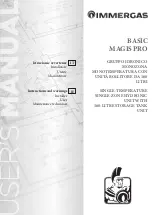
27
1.
Screw together the bottoms of fuel reservoir. The bottom of the reservoir must alternate with the fuel
reservoir A. As the joining material serve:
- Washer 6,4
72 pcs
- Nut M6
72 pcs
- Bolt M6 x 12
72 pcs
- Bolt M6 x 16
2 pcs
- Washer 8,4
2 pcs
2.
To this whole screw on gradually the side and leg of fuel reservoir.
3.
Set together in a similar way other 3 vertical walls of fuel reservoir.
4.
Screw the pendant chainlets to the fuel tank according to Fig.no.19.
5.
Screw the handle to the cover of the fuel reservoir by means of 2 screws M6 x 12
6.
Cover the whole with the fuel reservoir cover.
Note.:
Alternatively the rivets can be used as joining material for fuel reservoir assembly, except
position 6 and 7.
Fig. no. 19
Mounting of pendant chainlets to the fuel tank
6.7
Filling the heating system with water
Water for boiler and heating system filling must be clear and colourless, with no suspended materials, oil and
aggressive chemicals. Its hardness must correspond to
Č
SN 07 7401 and it is necessary that in case that the
water hardness doesn’t comply water must be treated. Even heating the water with a higher hardness several
times does not prevent the soils from getting precipitated on the boiler drum walls. Precipitation
of 1 mm calcite reduces at given point the passage of heat from the metal to water by 10%.
The heating systems with an open expansion reservoir allow a direct contact between heating water and
atmosphere. During the heating season the expanding water in the reservoir absorbs the oxygen which
increases the corrosion effect and at same time lot of water gets evaporated. It can only be replenished by
water treated according to
Č
SN 07 7401.
The heating system must be properly rinsed in order to wash out all impurities.
During the heating season the water volume in heating system must be kept constant. When refilling the
heating system it has to be prevented from air intake. Water from boiler and heating system must never be
discharged or taken for usage except for the emergency cases like repairs etc. Water discharge and filling
with new water increases the danger of corrosion and scale development.
In case we have to refill the heating system with water we only do this when the boiler is cold in order
to prevent the cast iron boiler drum from getting damaged.
After the fill-up check all joints at the boiler and heating system for their tightness!
The assembly completion and stoking test accomplishment must be recorded in “Guarantee
certificate”.
1. Pendant chainlet
2. Nut M6
3. Washer 6,4
4. Washer 8,4
5. Screw M6 x 16














































